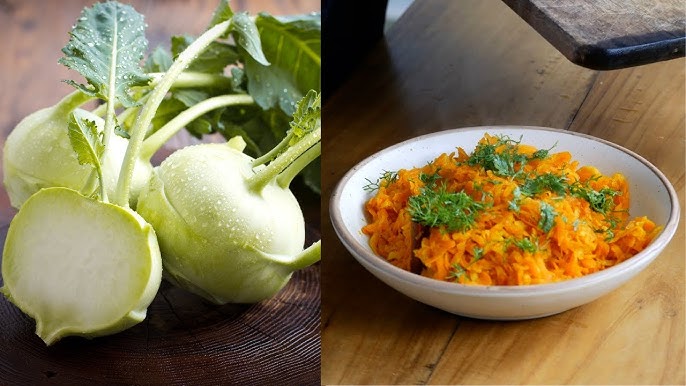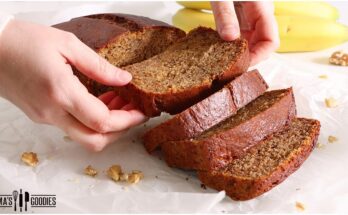Kohlrabi Recipe: Kohlrabi might not be the most common vegetable in your kitchen, but once you try it, you’ll wonder why you didn’t cook with it sooner! This bulbous veggie, often mistaken for a root vegetable, belongs to the same family as cabbage, broccoli, and Brussels sprouts.
What is Kohlrabi?
Kohlrabi, also known as the German turnip, has a mild, slightly sweet, and peppery taste similar to a mix of cabbage and broccoli stems. Both the bulb and the leaves are edible, making it a versatile addition to various recipes.
Nutritional Benefits of Kohlrabi
Kohlrabi is packed with essential nutrients:
- High in fiber – Great for digestion and gut health
- Rich in Vitamin C – Boosts immunity and promotes glowing skin
- Low in calories – Ideal for weight management
- Good source of potassium – Supports heart health and muscle function
Why Try This Kohlrabi Recipe?
This simple kohlrabi recipe brings out its natural flavors and makes it easy to incorporate into your meals. Whether roasted, stir-fried, or mashed, this guide will walk you through different methods to enjoy this underrated vegetable.
Ingredients Needed
Here’s what you’ll need to make a delicious kohlrabi dish:
Main Ingredients
- 2-3 medium kohlrabi bulbs
- 2 tablespoons olive oil or butter
- Salt and pepper to taste
Optional Add-ons for Extra Flavor
- Garlic powder or fresh garlic – Adds a deep, savory taste
- Parmesan cheese – For a nutty, cheesy flavor
- Lemon juice or vinegar – Enhances the sweetness of kohlrabi
- Herbs like thyme, parsley, or rosemary – Boosts aroma and taste
How to Prepare Kohlrabi
Before cooking kohlrabi, proper preparation is key to achieving the best texture and flavor.
Choosing the Best Kohlrabi
- Pick kohlrabi that is small to medium-sized, as larger ones can be tough and fibrous.
- The skin should be firm and smooth, without any soft spots.
- If buying with leaves, ensure they are fresh and green, not wilted.
Peeling and Cutting Methods
- Wash the kohlrabi thoroughly under running water.
- Cut off the stems and leaves (save them for stir-fries or salads).
- Peel the tough outer skin using a vegetable peeler or knife.
- Cut the kohlrabi into slices, cubes, or matchsticks, depending on your chosen cooking method.
Cooking Methods for Kohlrabi
Roasted Kohlrabi
Roasting brings out the natural sweetness of kohlrabi and gives it a crispy texture.
Steps to Roast Kohlrabi:
- Preheat oven to 400°F (200°C).
- Cut kohlrabi into bite-sized cubes or thin slices.
- Toss with olive oil, salt, pepper, and optional seasonings.
- Spread evenly on a baking sheet.
- Roast for 20-25 minutes, flipping halfway until golden brown and tender.
Tips for Crispy Roasted Kohlrabi:
- Avoid overcrowding the baking sheet.
- Roast at a high temperature for a crispy exterior.
Stir-Fried Kohlrabi
A quick and healthy way to enjoy kohlrabi with minimal effort.
How to Make a Kohlrabi Stir-Fry:
- Heat a wok or skillet over medium-high heat.
- Add olive oil or butter, followed by sliced kohlrabi.
- Stir-fry for 5-7 minutes until tender-crisp.
- Season with soy sauce, garlic, or chili flakes for extra flavor.
Mashed Kohlrabi
A great low-carb alternative to mashed potatoes!
Steps to Make Mashed Kohlrabi:
- Boil kohlrabi cubes in salted water for 15-20 minutes until soft.
- Drain and mash with butter, cream, and garlic.
- Add salt, pepper, and fresh herbs to enhance taste.
Serving Suggestions
Kohlrabi pairs well with:
- Grilled meats like chicken or steak
- Salads and grain bowls
- Egg dishes for a breakfast twist
Storage and Leftover Tips
- Store raw kohlrabi in the fridge for up to 2 weeks.
- Leftover cooked kohlrabi lasts 3-4 days in an airtight container.
Health Benefits of Kohlrabi
- Aids digestion due to its high fiber content.
- Supports heart health with potassium.
- Strengthens immunity with Vitamin C.
FAQs about Kohlrabi Recipe
What is kohlrabi and how does it taste?
Kohlrabi, often found in grocery stores and farmers markets, is a versatile vegetable from the cabbage family. It has a mild, sweet flavor with a crisp texture, similar to a broccoli stem or cabbage heart, making it perfect for a variety of dishes.
How do you prepare kohlrabi for cooking?
Preparing kohlrabi is simple. Start by removing the leaves and the tough outer skin with a vegetable peeler. The inside can be sliced, diced, or grated, depending on your recipe requirements. It’s important to wash it thoroughly before cutting.
Can kohlrabi be eaten raw?
Absolutely! Kohlrabi can be sliced thin and added to salads or used as a crunchy complement to dips. It’s also great pickled or in slaws, which enhances its natural flavors.
What are some popular kohlrabi recipes?
Kohlrabi is incredibly versatile. It can be roasted, sautéed, or steamed. Popular recipes include roasted kohlrabi with parmesan, kohlrabi slaw, and creamy kohlrabi soup. It pairs well with strong flavors like garlic, onion, and pepper.
Is kohlrabi nutritious?
Kohlrabi is highly nutritious, packed with fiber, vitamins C and B6, potassium, and magnesium. It’s low in calories, making it a great addition to any diet.
How do you store kohlrabi?
To store kohlrabi, place it in a plastic bag in the crisper drawer of your refrigerator. It typically lasts for a few weeks when stored properly. Keep it away from fruits like apples and bananas, which can cause it to spoil faster due to ethylene gas.
Conclusion
Kohlrabi is an incredibly versatile and nutritious vegetable that can be cooked in multiple ways. Whether roasted, stir-fried, or mashed, this recipe will help you make the most out of this underrated gem. Give it a try, and enjoy the delicious flavors!



